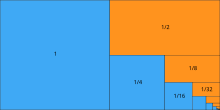Dotted note

In Western musical notation, a dotted note is a note with a small dot written after it. In modern practice, the first dot increases the duration of the basic note by half (the original note with an extra beam) of its original value. This means that a dotted note is equivalent to writing the basic note tied to a note of half the value – for instance, a dotted half note is equivalent to a half note tied to a quarter note. Subsequent dots add progressively halved value, as shown in the example to the right.[1][a] Though theoretically possible, a note with more than three dots is highly uncommon;[2] only quadruple dots have been attested.[3] If the original note is considered as being of length 1, then a quintuple dot would only be 1/32 longer than the quadruple dotted note.[b] The difficulty may be seen by comparing dotted notation to tied notation: a quarter note (![]() ) is equivalent to 2 tied eighth notes (
) is equivalent to 2 tied eighth notes (![]() ), a dotted quarter = 3 tied eighth notes, double dotted = 7 tied sixteenth notes (
), a dotted quarter = 3 tied eighth notes, double dotted = 7 tied sixteenth notes (![]() ), triple dotted = 15 tied thirty-second notes (
), triple dotted = 15 tied thirty-second notes (![]() ), and quadruple dotted = 31 tied sixty-fourth notes (
), and quadruple dotted = 31 tied sixty-fourth notes (![]() ). Although shorter notes do occur, sixty-fourth notes are considered the shortest practical duration found in musical notation.[4]
). Although shorter notes do occur, sixty-fourth notes are considered the shortest practical duration found in musical notation.[4]
| Undotted | 1 dot | 2 dots | 3 dots | 4 dots | |
|---|---|---|---|---|---|
| Lengthens | NA () | ||||
| Result |
The use of a dot for augmentation of a note dates back at least to the 10th century, although the exact amount of augmentation is disputed; see Neume.
A rhythm using longer notes alternating with shorter notes (whether notated with dots or not) is sometimes called a dotted rhythm. Historical examples of music performance styles using dotted rhythms include notes inégales and swing. The precise performance of dotted rhythms can be a complex issue. Even in notation that includes dots, their performed values may be longer than the dot mathematically indicates, a practice known as over-dotting.[5]
Notation[]
If the note to be dotted is on a space, the dot also goes on the space, while if the note is on a line, the dot goes on the space above (this also goes for notes on ledger lines).[6]
The placement of dots gets more complicated for adjacent-note chords and for lower voices, as shown below.
The dots on dotted notes, which are located to the right of the note, should not be confused with the dots for staccato articulation, which are located above or below the note.
Theoretically, any note value can be dotted, as can rests of any value. If the rest is in its normal position, dots are always placed in third staff space from the bottom, as shown in the example below.[7]
Dots can be used across barlines, such as in H. C. Robbins Landon's edition of Joseph Haydn's Symphony No. 70 in D major, but most writers today regard this usage as obsolete and recommend using a tie across the barline instead.[8]
Double dotting[]

A double-dotted note is a note with two small dots written after it. Its duration is 1+3⁄4 times its basic note value. The double-dotted note is used less frequently than the dotted note. Typically, as in the example to the right, it is followed by a note whose duration is one-quarter the length of the basic note value, completing the next higher note value. Before the mid-18th century, double dots were not used. Until then, in some circumstances, single dots could mean double dots.[9]
In a French overture (and sometimes other Baroque music), notes written as dotted notes are often interpreted to mean double-dotted notes,[10] and the following note is commensurately shortened; see Historically informed performance.
Triple dotting[]

A triple-dotted note is a note with three dots written after it; its duration is 1+7⁄8 times its basic note value. Use of a triple-dotted note value is not common in the Baroque and Classical periods, but quite common in the music of Richard Wagner and Anton Bruckner, especially in their brass parts.[citation needed]
An example of the use of double- and triple-dotted notes is in Frédéric Chopin's Prelude in G major for piano, Op. 28, No. 3. The piece, in common time (4
4), contains running semiquavers (sixteenth notes) in the left hand. Several times during the piece Chopin asks for the right hand to play a triple-dotted minim (half note), lasting 15 semiquavers, simultaneously with the first left-hand semiquaver, then one semiquaver simultaneously with the 16th left-hand semiquaver.
See also[]
Notes and references[]
Notes
- ^ If the base note is 1, then the xth dot adds the length (1/2, 1/4, 1/8, ...).
- ^ Tempos vary from ≤24 beats per minute to ≥200 bpm; at a slow Larghetto tempo of quarter note = 60 (one quarter note per second; 60 bpm), the length of a quintuple dotted note is 0.03125 seconds longer than a quadruple dotted note and presumably below the JND for musical duration and too fast to allow proper counting and accuracy.
References
- ^ Read 1969, p. 114, ex. 8–11; p. 116, ex. 8–18; p. 117, ex. 8–20.
- ^ Bussler, Ludwig (1890). Elements of Notation and Harmony, p. 14. 2010 edition: ISBN 1-152-45236-3.
- ^ "Extremes of Conventional Music Notation". indiana.edu.
- ^ Morehen, John. 2001. "Hemidemisemiquaver". The New Grove Dictionary of Music and Musicians, second edition, edited by Stanley Sadie and John Tyrrell. London: Macmillan.
- ^ Hefling, Stephen E. (2001). "Dotted rhythms". In Root, Deane L. (ed.). The New Grove Dictionary of Music and Musicians. Oxford University Press.
- ^ Glen Rosencrans, Music Notation Primer. New York: Passantino (1979): 29
- ^ Read 1969, pp. 117–118. "Ranging from Renaissance madrigals to the keyboard works of Johannes Brahms, one often finds such a notation as the one at the left below." (The next page shows an example labeled "older notation" of two measures of music in 4
4 of which the second measure contains, in order: an augmentation dot, a quarter note and a half note.). - ^ Taylor, Eric (2011). The AB Guide to Music Theory Part I. ABRSM. p. 18. ISBN 978-1-85472-446-5.
- ^ Adam Carse, 18th Century Symphonies: A Short History of the Symphony in the 18th Century. London: Augener (1951): 28. "Contemporary theorists made it clear that the dotted note should be sustained beyond its actual value (the double dot was not then in use), and that the short note or notes should be played as quickly as possible."
Sources
- Read, Gardner (1969). Music Notation: A Manual of Modern Practice (2nd ed.). Boston: Allyn & Bacon.
External links[]
 Media related to Dotted notes at Wikimedia Commons
Media related to Dotted notes at Wikimedia Commons- "Learn to Read Drum Music – Part 6 – Dotted Notes Explained", thenewdrummer.com
- Note values














